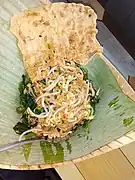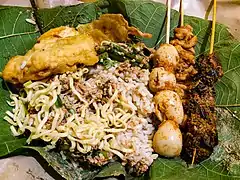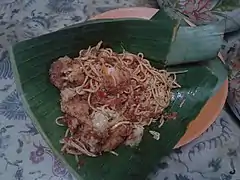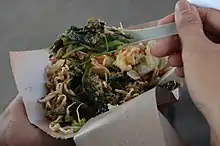 | |
| Alternative names | Pecal |
|---|---|
| Place of origin | Indonesia |
| Region or state | Ponorogo, Madiun, Ngawi, Yogyakarta, Central Java, East Java |
| Serving temperature | Room temperature |
| Main ingredients | Vegetables in peanut sauce |
Pecel (Indonesian pronunciation: [pət͡ʃəl], Javanese:ꦥꦼꦕꦼꦭ꧀) is a traditional Javanese salad with peanut sauce,[1] usually eaten with carbs (steamed rice, lontong or ketupat).[2][3]
The simplicity of pecel preparation and its cheap price has contributed to its popularity throughout Java. It has become a food that represents practicality, simplicity, and travel since the dish is often found along the train journey across Java.[4]
Pecel was introduced to Malaysia, where it is known as pecal,[5] by Javanese immigrants. Pecel is also very popular in Suriname, where it was introduced by the Javanese Surinamese.
History
In Babad Tanah Jawi (circa 17th century), Ki Gede Pemanahan referred to the dish he presented to his guest, Sunan Kalijaga as "pecel-ised boiled vegetables". In Javanese language, "pecel" used to refer to the act of squeezing the water out of something.[6]
Sunan Kalijaga was not familiar with the dish as he came from the northeastern part of Central Java, while the dish was native to Yogyakarta.[7] This dish became one of the most popular Javanese dishes soon after it was introduced to other regions of Java, and the word pecel took its current meaning, "a side dish that is made of vegetables and sauce".[8]
Pecel is only one of many Javanese vegetable-based salads. It is similar to lothek, except that lothek is usually served with fried batter or tofu and uses both raw and cooked vegetables.[9]
Ingredients
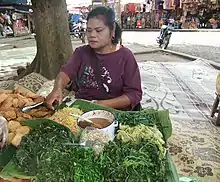
The main ingredients usually consist of leafy vegetables, bean sprouts (or any other plant sprouts), long beans, and cabbages. Some other types of vegetables can also be added. People may use amaranth leaves, kangkung, cassava leaves, or leaves or any other local plants that are in season. Some modern recipes will add carrots (sliced) into the mix, or replace white cabbages with red ones to spice up the color.
The sauce is made of roasted (or fried) peanuts, asam jawa, coconut sugar, and other spices. It might be served thick or watery, sweet or spicy, depending on the regional variation.[10] [11]
Pecel is usually eaten with rice or rice cake (lontong or kupat). It can also be eaten alone or with fried side dishes, such as fried tempeh, tofu, etc.; and Javanese crackers, such as krupuk or rempeyek.[12]
Variants
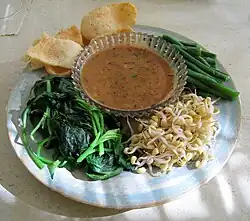
The difference usually lies in the thickness level of the sauce, and the taste profiles (spicy, sweet, or savoury). In Central Java, pecel sauce is sweet-savoury with medium thickness, except in the northern coast and north-eastern regions where the sauce tends to be spicier and the sauce is usually a bit thinner than usual. In East Java, especially Madiun, the peanut sauce is very thin and spicy. Lamtoro seeds are often added as a topping.
In Tegal, Central Java, pecel sauce is made of peanut and cassava root. In Surakarta's pecel ndeso, black sesame sauce is used on top of peanut sauce.[13]
In Yogyakarta, pecel is served with bacem (sweet-simmered) tempeh or tofu. In Surakarta, a pecel variant called lothek (alt. spelling: lotek) includes the use of some raw vegetables, lontong, and gorengan. The name "lothek" is derived from "luthik", a wooden spatula used to scoop the peanut sauce from a cowek (grinding bowl).[14]
Pecel tumpang is a pecel smothered with tumpang (tempeh sauce). It is a delicacy of Kertosono District in Nganjuk.[15]
Mie pecel or pecel mie, noodles with pecel sauce common in Central Java as well as Medan. One of them is pecel mie kenyol from Batang, the noodle made from cassava with a chewy texture.[16]
Gallery
See also
References
- ↑ Putra AW, Nedi (24 October 2019). "Digging into the history of 'pecel'". The Jakarta Post. Retrieved 2019-10-24.
- ↑ Pecel Recipe (Java Style Salad with Peanut Sambal)
- ↑ Vegetable Salad with Peanut Sauce, Pecel Archived 2015-01-19 at the Wayback Machine
- ↑ Agmasari, Silvita (24 February 2018). "Asal Usul Pecel, Makanan untuk Semua Kalangan yang Kaya Gizi". KOMPAS.com (in Indonesian). Retrieved 2019-10-24.
- ↑ "Buffet features favourite dishes of Malaysia's first four prime ministers". The Star (Malaysia). 31 July 2013. Archived from the original on 26 September 2013. Retrieved 26 August 2013.
- ↑ "Sejarah Pecel Diceritakan dalam Babat Tanah Jawi, Jadi Simbol Perjalanan dan Kesederhanaan". Tribun Travel (in Indonesian). Retrieved 2019-10-24.
- ↑ "Sejarah Munculnya Pecel, Makanan Lokal Yang Kaya Gizi".
- ↑ Poerwadarminta, W. J. S. (1939). Bausastra.
- ↑ "Resep Lotek Yogyakarta, Sayur Rebus Siram Bumbu Kacang buat Sarapan". KOMPAS.com (in Indonesian). 2021-02-07. Retrieved 2021-03-06.
- ↑ "Macam-Macam Pecel di Indonesia, Apakah Ada Pecel Khas Daerahmu? - Bobo". bobo.grid.id (in Indonesian). Retrieved 2021-03-06.
- ↑ Kuliner, ChoirulAdnan (2016-06-21). "Pecel. Salad Lokal Yang Ternyata Punya Banyak Macam". Yuk Piknik. Retrieved 2021-03-06.
- ↑ "Peyek, Makanan Pelengkap Khas Indonesia yang Terkenal Renyah – Bobo". bobo.grid.id (in Indonesian). Retrieved 2021-03-06.
- ↑ "Pecel Ndeso, Kuliner Enak dengan Sambal Wijen Khas Solo". Traveling Yuk. 2017-12-02. Retrieved 2021-03-06.
- ↑ Poerwadarminta, W.J.S. (1939). Bausastra.
- ↑ "Menikmati Hidden Gem Nasi Pecel Tumpang". dhahanews.com. Retrieved 8 April 2023.
- ↑ "Menyantap Pecel Mie Kenyol Khas Batang". jatengprov.go.id (in Indonesian). The Government of Central Java. Retrieved 10 November 2022.
